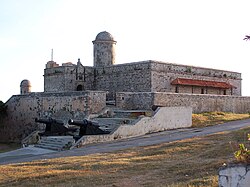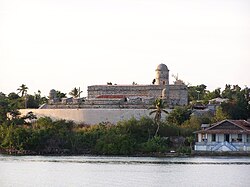| This article needs additional citations for verification. Please help improve this article by adding citations to reliable sources. Unsourced material may be challenged and removed. Find sources: "Castillo de Jagua" – news · newspapers · books · scholar · JSTOR (February 2016) (Learn how and when to remove this message) |
| Castillo de Jagua | |
|---|---|
 | |
 | |
| General information | |
| Architectural style | Spanish Colonial architecture |
| Town or city | Cienfuegos |
| Country | |
| Coordinates | 22°04′N 80°28′W / 22.067°N 80.467°W / 22.067; -80.467 |
| Completed | 1742 |
The Castle of Jagua (Spanish: Castillo de Jagua) is a fortress south of Cienfuegos in Cuba. It is located near the entrance to the Cienfuegos Bay (Spanish: Bahia de Cienfuegos), in the port of Jagua. It was originally named "Castillo (or Fortaleza) de Nuestra Señora de los Ángeles de Jagua" (Castle -or Fortress- of Our Lady of the Angels of Jagua). It was built in 1742.
History



The fortress, also called the castle, was erected by King Philip V of Spain (1683-1746) in 1742 to protect the bay from pirates who prowled the Caribbean coast in those days. They used it as refuge at landfall, on their way to the city of Cienfuegos (founded on April 22, 1819, by French colonists, bordering the Bay of Jagua), seeking collect water, food and other supplies.
The fort is built in solid limestone, has several floors, a well, a watch tower and a moat that was never flooded. It also has a drawbridge in perfect condition, one of the last to remain fit for use.
Since the coastal city of Cienfuegos was built at the end of the 1810s; its harbor, guarded by the fortress, became one of the most important centers of commerce in the central part of the "Island of Cuba" during that period of the colony, and to this day remains one essential port on the country's economy.
Publications and others graphic demonstrations, have been in charge for long time, that these marvels of Cuban colonial architecture, not be forgotten. This is the case of banknotes, "Exchange Certificate" of 10 pesos, Letters A (reds) and B (greens), issued during the 1980s, and taken out of circulation, "as special legal tender" in the late 1980s and early 1990s; in its back, these banknotes, have a beautiful and attractive design of that "Castle" (a great drawing) to perpetuate forever, in the Numismatics history of the Big Island of the Antilles.
The castle is located in front of the entrance to the bay. Nearby is the abandoned Nuclear City that was never completed due to the disintegration of the USSR.
Gallery
-
 Castillo de Jagua, photo of 1925.
Castillo de Jagua, photo of 1925.
-
 Chapel of the Castillo de Jagua (from the 18th-century), photo of 1945.
Chapel of the Castillo de Jagua (from the 18th-century), photo of 1945.
-
 Castillo de Jagua, postcard of 1940.
Castillo de Jagua, postcard of 1940.
-
 Gate and drawbridge
Gate and drawbridge
See also
References
- "Six Cuban Views - Castle at the Entrance of Cienfuegos". picryl.com. 1874.
External links
![]() Media related to Castillo de Jagua at Wikimedia Commons
Media related to Castillo de Jagua at Wikimedia Commons